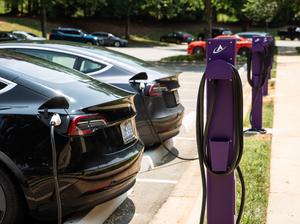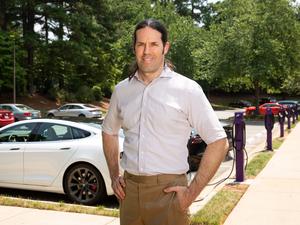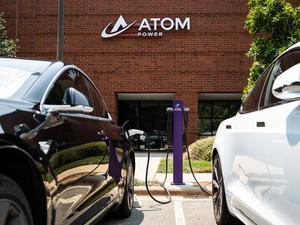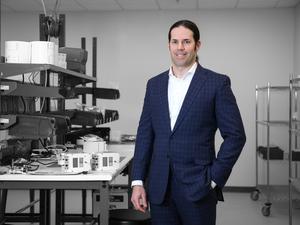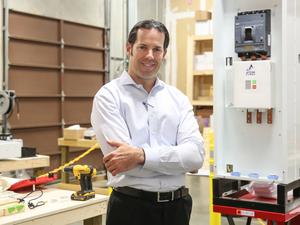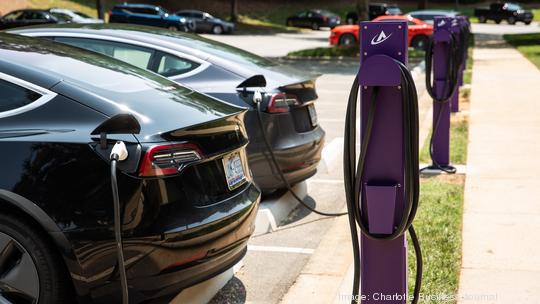
Atom Power has launched its electric vehicle charging product line — called PURPL — clearing the way to deliver that equipment and more than 7,000 charging stations already on order in seven states.
The new line is focused on charging services for corporate fleets and for multifamily units. It is based on the Charlotte startup’s signature product, a digital circuit breaker it developed in 2014 for power control systems in industrial and commercial real estate. After being approached by a major utility and a multifamily builder in 2020, Atom Power realized its greatest immediate potential was in vehicle charging systems.
“Our biggest market right now is New York, where opportunities for us just continue to grow,” says CEO and founder Ryan Kennedy, looking at the order pipeline for the new product. “We have projects here locally as well, but they are smaller than in New York.”
He says there are three projects in North Carolina, including in Charlotte. Those all focus on fleet charging. In New York, he says, the focus has been largely on charging for multifamily projects — apartments and co-ops. And that has generally meant a lot more charging stations.
In fact, its largest customer in New York has just increased the size of its order. In October, Atom Power announced that ESD Global had ordered 355 charging stations for a 900-apartment cooperative in Queens. Now ESD has raised that order to 550 charging stations as it looks at installing the technology at additional sites.
'Charge-ready' product
Duke Energy Carolinas is installing the PURPL system and several charging stations at its Emerging Technology and Innovation Center in Mount Holly, testing the product for possible use on its own corporate electric fleet.
In addition to New York and North Carolina, PURPL systems and chargers are on order for customers in Florida, California, Oregon, Texas and South Carolina, Kennedy says. Atom Power expects to fill those initial orders in the first quarter of 2022.
Kennedy says using Atom Power’s digital circuit breakers as the control system for vehicle charging can reduce the infrastructure that must be installed to allow for multiple charging stations for large users. It also makes it easier to design a vehicle-ready system that can be easily and inexpensively scaled up as needed by corporate and residential development customers.
He says the system pairs well with “make-ready” or “charge-ready” EV incentives offered in states like New York and California and cities such as Atlanta and Seattle.
The charging stations themselves do not require expensive electronics needed for most vehicle chargers because the system is regulated by the circuit breakers and not by any equipment in the chargers. The PURPL charging stations are essentially pedestals with wiring and cost about $400 to $500 apiece. Standard charging stations, Kennedy says, can cost thousands of dollars to replace if damaged.
Residential products coming
The announced projects in New York and the local projects were booked before the formal product launch.
“They all took a leap of faith,” Kennedy says. “For most project managers, they want to wait until the product releases, which is what we have done now.”
Atom Power continues to market its circuit breakers for power distribution and management in commercial and industrial facilities — the purpose for which Kennedy and his team initially developed its products.
After the push into vehicle charging this year, Kennedy says Atom Power will focus on residential circuit breaker markets in 2022. Those will be for single-family homes to take advantage of demand-side management programs and products offered and to effectively manage rooftop solar systems, particularly those used with battery storage.
Atom Power last fall acquired a 23,000-square-foot building in Huntersville to serve as its headquarters and a manufacturing plant, largely to ramp up for production of its electric-vehicle hardware. And it continues to search for as much as 150,000 square feet of space for a larger production site.
“We have space now to produce the EV charging products we have today, but the focus on that expansion is really on the residential products that are coming out next year,” Kennedy says. “That requires a whole lot more space, based on the demand we're seeing for those products.”
